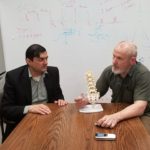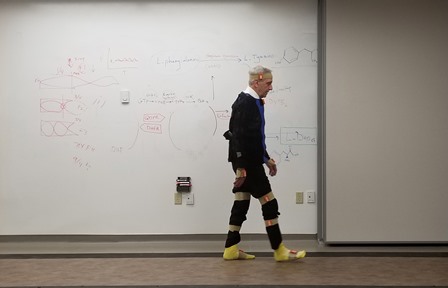By Laura Goncalves
For patients living with Parkinson’s disease, it is common to develop significant motor symptoms especially as the disease progresses. Many experience issues with walking, freezing and instability.
This can cause people to have difficulties walking to the point of needing assistance, including being bound to walkers and wheelchairs or motorized devices, and those who are housebound and even bedridden the majority of the time. For many, they are simply unable to walk steadily without assistance which can greatly impact their everyday life.
These symptoms are largely resistant to the common dopamine replacement therapy. The benefits of deep brain stimulation have proven to be limited and unpredictable, and this option is only available to a fraction of patients.

“Introducing a novel therapeutic intervention is a significant unmet need for patients with Parkinson’s who don’t have other treatment options,” explains Dr. Mandar Jog, Assistant Director at Lawson Health Research Institute and Professor at Western University.
He is the lead for a research team in London, Ontario that is the first in the world to successfully trial an implant in the spine that boosts the signals between the body, spinal cord and brain. They have shown that supporting the signals moving from the body towards the brain can greatly improve movement and stop the freezing as patients walk.
Dr. Andrew Parrent, Neurosurgeon at London Health Sciences Centre, collaborates with Dr. Mandar Jog on this research and implants the devices into the research participant’s spinal cord. “A wire is threaded in the dorsal area of the spine and attached to the stimulator implanted in the body.”

The stimulator is rechargeable for up to 15 years and comes with a remote control. “They can easily turn the electrical signal on or off, and dial the strength up or down,” explains Dr. Parrent. The research team programs the device for each individual patient and is monitoring the results over time.
“We’ve previously seen progress in the therapeutic use of spinal cord stimulation and didn’t know if we would see any improvement for our patients. The results have been astonishing – with patients who previously could not walk independently now making tremendous advances,” says Dr. Jog. “The best part is that their confidence levels have gone up. They can get back to doing the things in life that many of us take for granted, like taking a walk in the park or going on vacation.”
Dr. Jog sees potential for this to be routinely used as an effective and cost-efficient treatment for a significant proportion of patients with Parkinson’s disease. “The results from the past three years are showing us that the treatment is long-lasting and the effects continue for a time even after the implant is turned off.
Laura Goncalves is a Communications Consultant at Lawson Health Research Institute.


